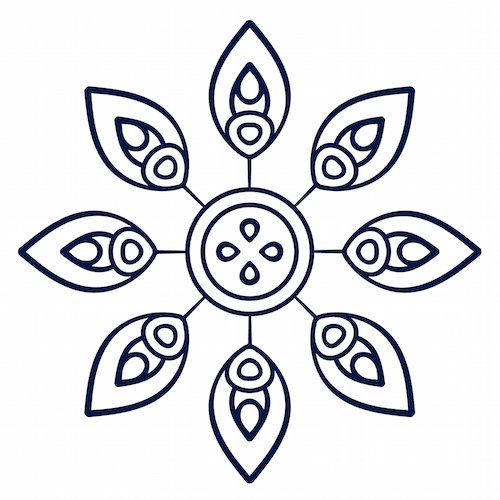Simple Mandalas

The simplest mandala pattern features a central image, typically in a circle, that radiates outward with symmetrical designs, such as the rays of the sun or the petals of a flower stretching to the outer circle. They may also include repeating scrolls or interlocking knots. These mandalas are ideal for young children as the individual segments are relatively large and easy to for little hands to color.
Simple Mandala Designs for Children
Art teachers often introduce young children to mandala designs to enhance their understanding of symmetry and to encourage the use of contrasting and complementary colors. Coloring the designs also builds fine motor skills and helps to focus energy. The simplicity of the design and the use of bright colors also appeals to young children. Children as young as kindergarten can color simple mandalas that contain two colors. These may include flowers, a smiling sun with bright rays or a simple geometric design. As the child matures, more complex designs that require more colors and more fine motor control can be added.
Benefits of Introducing Children to Mandalas
There are a number of positive aspects to introducing young children to mandalas. Some of the most common reasons are:
- Builds Math Skills: Coloring mandalas typically requires an understanding of sequencing or creating patterns with color. It also encourages recognition of geometric shapes, symmetry and spacial awareness.
- Builds Language Skills: Coloring mandalas also builds language skills as children learn to talk about the patterns they have created, discuss similarities and differences between their mandala and those of their peers, and use new vocabulary.
- Builds Fine Motor Skills: Coloring builds the fine muscles in the hands and fingers and strengthens eye-hand coordination.
- Improves Concentration and Focus: Many report that coloring mandalas improves both concentration and focus and has a calming effect on children.
- Teaches Color Awareness: The nature of mandalas encourages the use of color to create patterns with contrasting or complementary colors. For the very young, it reinforces color identification, too.
- Teaches Visual Discrimination: Learning to color certain parts of the design one color while other parts are colored differently gives children practice with visual discrimination as they locate and identify parts of the mandala.

Are Simple Mandalas Just for Kids?
While simple mandala coloring pages are often used to introduce children to mandalas they can be used by anyone. The elderly or those who have difficulty with fine motor skills may find them easier to work with. They may also allow those with vision problems to participate in coloring (or creating) mandalas without straining to see all the parts.
Simple mandala patterns are also well suited for craft projects and in handcrafts such as quilting or applique. A complex design may be overwhelming in this context. A simple mandala design can be used instead to create a striking piece of art that plays with color and geometric design.
Where Do You Find Simple Mandalas?
You can often find simple mandalas in children’s storybooks or coloring books. These can be used as coloring pages to create colorful and personalized mandalas or used as patterns for adult artwork. Some quilt and applique books also contain simple mandala designs that can be adapted for other projects.
